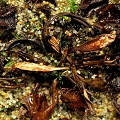Q: Is my plant dormant or dead?

She's dead, Jim.
A: This is a frequent question for two reasons. First, lots of people
kill their flytraps, and in desperation they cling onto the "last hope" that
their plants are dormant. Second, lots of people are impatient for their
plants to come out of dormancy, and insist on poking around in the soil
(claiming to be determining if the plant is still OK) when the plant should be left alone.
It is easy to differentiate between a Venus flytrap that is dying, versus one that is entering
dormancy.
A dying Venus flytrap gives up the
ghost fairly quickly. The leaves die completely, and
all that remains of the plant is something all mushy and gooey. Freeze a lettuce leaf and then
thaw it on your counter-top to see what a dying Venus flytrap looks like. Pathetic.
In contrast, a Venus flytrap entering dormancy merely slows in growth, and often the leaves blacken
and die over several weeks. All the clones that I grow retain at least a few green leaves
even in dormancy.
(I note that some cultivars, such as the lovely red Dionaea 'Clayton's Red Sunset', supposedly
die back entirely during the winter, but I haven't seen this to be the case with my plants.)
If your plant has stopped growing for about two months, it is either
dormant or dead. How can you tell the difference? First off,
if it is autumn, it is likely to be going dormant. If
your plant has green on the above-ground parts, it is dormant.
Even if all the above-ground parts are black and horrid, it is not
necessarily dead. The best thing you can do is wait! Yes, just sit on
your hands for another month. I guy I knew back when I was first starting to grow
carnivorous plants called it the dread "P-word", i.e., patience! (Rob M,
where are you??)
If the plant is dormant, it wants to be
left alone. If the plant is dead, well, it does not matter, now does it? So
leave the plant alone. You are likely to harm the plant by monkeying
around with it.
Of course, your species split the atom to make
bombs and will soon clone humans,
so you'll probably need to stick your meddling fingers in here, too. So
if you really must risk your plant's health in order to satisfy your
insatiable curiosity, carefully dig the plant out of the ground.
If the bulb is rotten, mushy, and smelly, you are the owner of a dead
plant. Dang! If the bulb is crisp, your plant is sleeping. Only now
your poking around has given it a
damaged root system and possibly even gashes in
the bulb. Fungal infection, rot, and death is now much more likely. Drat!
"Duuhh, maybe we shouldn't have cloned humans after all...duuuuhhh."
Page citations: Personal observation.